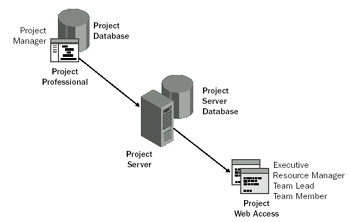Understanding Project Server Components
Understanding Project Server Components
The core components of Microsoft Project workgroup collaboration and enterprise project management are as follows :
Project Professional. The origin of all project data, including tasks , resources, assignments, scheduling dates, costs, and tracking information. The Microsoft Project database stores all project information managed from Project Professional. Through the Microsoft Project database, Project Professional interfaces with Project Server.
Project Server. Essentially a server and database custom-designed to convert data to and from your project plan and to interface with Project Web Access using that data. The Project Server database stores information related to security settings, administrative settings, and all other information related to Project Web Access. Project Server is a separate application containing business logic and functionality to process this data.
Project Web Access. A Web site with unique capabilities to work specifically with Project Server and display targeted project data. It is the view into the Project Server. This Web site typically lives on your organization's intranet and is accessed by project team members entering via some type of user authentication. Some Project Web Access features can also be accessed from within Project Professional.
| Note | Depending on other resources in use by your organization, you can also integrate these other components for additional functionality:
|
Here's a description of the interaction between the three Microsoft Project components in a little more detail:
-
Project data saved to the project server using Project Professional is saved to Project Tables in a certain area of the Project Server database. This is the only area of the database with which Project Professional reads or writes , and it is not used by Project Web Access.
-
When projects are published (rather than simply saved ), a command is sent to the project server to process the data about the project held in the Project Tables. These data are saved in a separate part of the database: in the Views Tables . The Views Tables are accessed by Project Web Access when users view project, resource, or assignment information using their browsers.
-
Both Project Server and Project Web Access use XML to pass data. In addition, Project Web Access uses HTML and ASP to present that data and build interactive features. Other technologies, such as ActiveX controls, contribute to the capabilities of the Project Web Access interface.
When you change data in your project plan, it's changed in the Project Tables area of the Project Server database. When you publish the information to Project Server, relevant data are parsed into XML formats, read into the Project Server database, and then saved to the Views Tables in the Project Server database ”where it is converted back from XML into HTML-rendered text (see Figure 20-1). All this in a blink of an eye (or as many blinks as determined by your network configuration and database size ).

Figure 20-1: Publish information from Project Professional, and it is converted in Project Server to be displayed in Project Web Access.
These components work together to provide team collaboration as well as enterprise project management functionality.
| Cross-References | For more information about the Microsoft Project database, the Project Server database, and how the two interact, see Chapter 32, "Working with Microsoft Project Data." |
EAN: 2147483647
Pages: 268